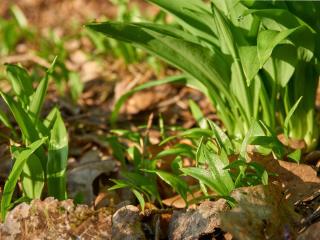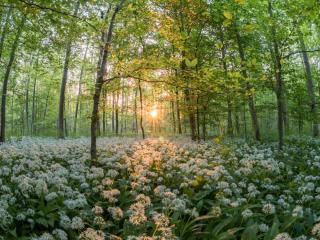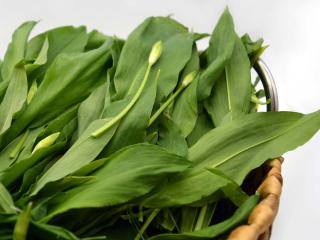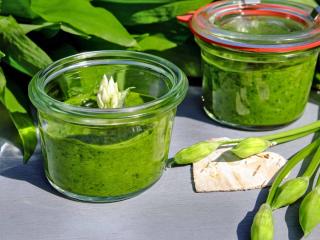

Wild garlic is a flavorful and medicinal plant packed with benefits
Key Wild garlic facts:
Latin name: Allium ursinum
Common name: bear’s garlic, wild ~
Family: Amaryllidaceae
Type: perennial aromatic and medicinal
Height: 16 inches (40 cm)
Exposure: partial shade, shaded
Soil: heavy, humus-rich, and cool
Planting: July – Harvest: end of July to September
Wild garlic, a perennial plant from Europe and Asia, thrives wild in woodlands. Easy to grow and low maintenance, people cultivate Allium ursinum for its flavorful leaves that elevate many dishes.
A great source of nectar, this condiment plant showcases beautiful clusters of white flowers. Detoxifying and antiseptic, wild garlic offers medicinal benefits similar to regular garlic.
→ A note of caution: Don’t confuse wild garlic with lily of the valley. Their foliage looks alike, but while Allium ursinum leaves are edible, lily of the valley leaves are highly toxic!
 Planting distance: about 8 inches (20 cm).
Planting distance: about 8 inches (20 cm).
Bulbs of bear’s garlic are best planted in fall or spring, in loose soil that’s been well-worked and enriched with compost. Plant bulbs at a depth of 2 inches (5 cm), spacing them about 8 inches (20 cm) apart in all directions.
Then, sprinkle water lightly over them. Once more, make sure your soil stays nicely moist during the first growing season.
Seeding wild garlic, a natural perennial, can be a tad tricky. To simulate winter, put your seeds in the fridge for about a month to boost germination.
Directly sow in July in a partially shaded spot in compost-enriched soil. Sprinkle the seeds atop a wet layer of seeding compost and barely cover the seeds. Typically, germination takes 3 to 4 weeks.
Water the seeds gently once a week through September. If it’s exceptionally dry, keep the soil moist. Thin the Allium ursinum plants in their second growing year. Space them to about 8 inches (20 cm) in all directions.
Bear’s garlic is a shade-loving forest plant, preferring heavy, organic-rich soils that are consistently moist.
This hardy plant does great both in garden soil and containers.
 Caring for bear’s garlic is easy. Just give it some regular, light watering during dry spells.
Caring for bear’s garlic is easy. Just give it some regular, light watering during dry spells.
Add mulch around your Allium ursinum plants in summer to keep that soil moisture level up.
💡 Fun fact: bear’s garlic can be quite an invader. To control its spread, snip off spent flowers to keep its spreading in check.
Bear’s garlic doesn’t catch diseases easily. Its main worry, as for other allium plants, is the onion fly.
 Begin your wild garlic harvest a year after planting. Harvest leaves and flowers as you need, ensuring you leave the root bulb intact.
Begin your wild garlic harvest a year after planting. Harvest leaves and flowers as you need, ensuring you leave the root bulb intact.
Consume them soon after harvesting because wild garlic doesn’t store well for long. You can, however, dry leaves or freeze them for longer storage. This might dull their flavor a tad.
→ Smart tip: Harvest leaves before they flower to relish a more intense aroma.
 Wild garlic leaves pack a vitamin punch and have a feel pretty similar to lettuce.
Wild garlic leaves pack a vitamin punch and have a feel pretty similar to lettuce.
Enjoy leaves, stems, and flower buds raw in salads, or cooked in sauces like pesto, soups, or as a side with your veggie, fish, and poultry dishes.
Just remember, cooking dampens its strong aroma a bit.